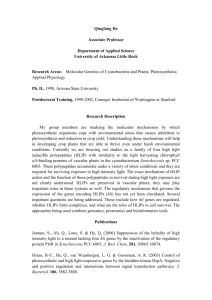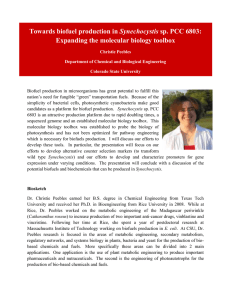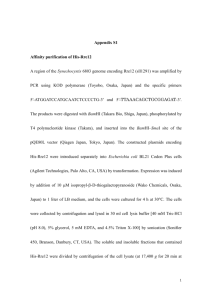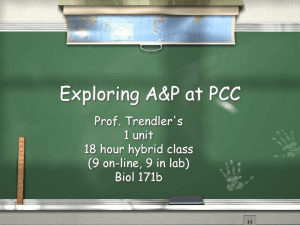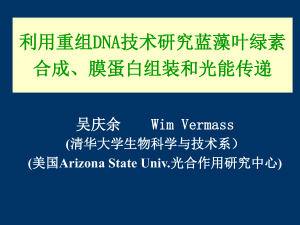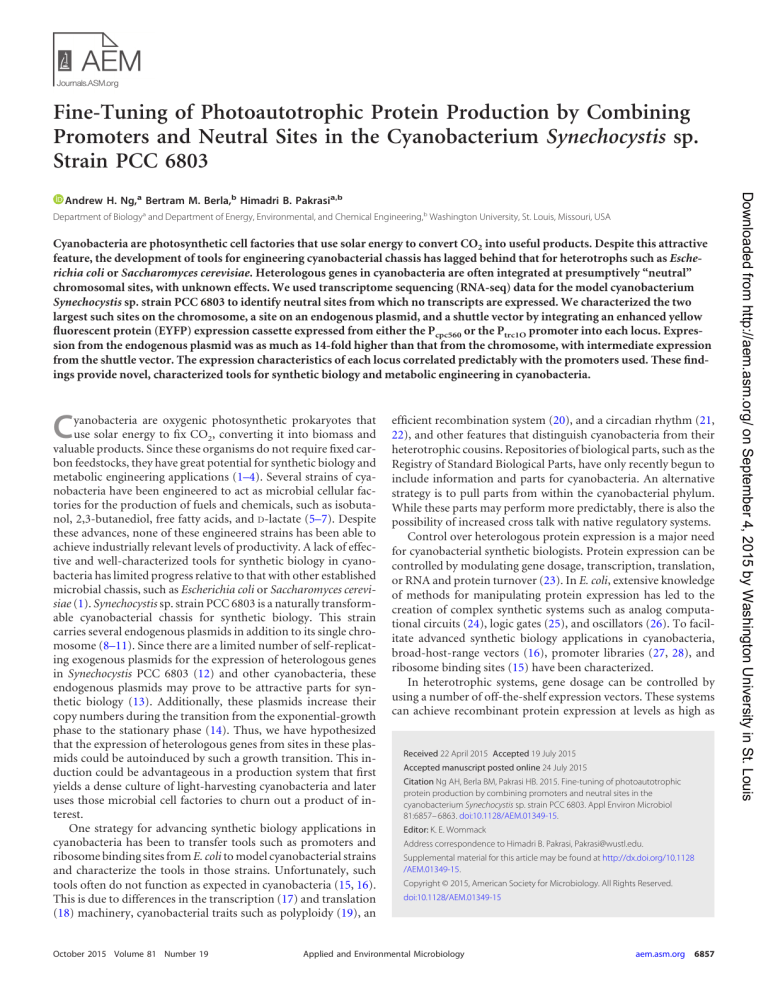
Fine-Tuning of Photoautotrophic Protein Production by Combining
Promoters and Neutral Sites in the Cyanobacterium Synechocystis sp.
Strain PCC 6803
Department of Biologya and Department of Energy, Environmental, and Chemical Engineering,b Washington University, St. Louis, Missouri, USA
Cyanobacteria are photosynthetic cell factories that use solar energy to convert CO2 into useful products. Despite this attractive
feature, the development of tools for engineering cyanobacterial chassis has lagged behind that for heterotrophs such as Escherichia coli or Saccharomyces cerevisiae. Heterologous genes in cyanobacteria are often integrated at presumptively “neutral”
chromosomal sites, with unknown effects. We used transcriptome sequencing (RNA-seq) data for the model cyanobacterium
Synechocystis sp. strain PCC 6803 to identify neutral sites from which no transcripts are expressed. We characterized the two
largest such sites on the chromosome, a site on an endogenous plasmid, and a shuttle vector by integrating an enhanced yellow
fluorescent protein (EYFP) expression cassette expressed from either the Pcpc560 or the Ptrc1O promoter into each locus. Expression from the endogenous plasmid was as much as 14-fold higher than that from the chromosome, with intermediate expression
from the shuttle vector. The expression characteristics of each locus correlated predictably with the promoters used. These findings provide novel, characterized tools for synthetic biology and metabolic engineering in cyanobacteria.
C
yanobacteria are oxygenic photosynthetic prokaryotes that
use solar energy to fix CO2, converting it into biomass and
valuable products. Since these organisms do not require fixed carbon feedstocks, they have great potential for synthetic biology and
metabolic engineering applications (1–4). Several strains of cyanobacteria have been engineered to act as microbial cellular factories for the production of fuels and chemicals, such as isobutanol, 2,3-butanediol, free fatty acids, and D-lactate (5–7). Despite
these advances, none of these engineered strains has been able to
achieve industrially relevant levels of productivity. A lack of effective and well-characterized tools for synthetic biology in cyanobacteria has limited progress relative to that with other established
microbial chassis, such as Escherichia coli or Saccharomyces cerevisiae (1). Synechocystis sp. strain PCC 6803 is a naturally transformable cyanobacterial chassis for synthetic biology. This strain
carries several endogenous plasmids in addition to its single chromosome (8–11). Since there are a limited number of self-replicating exogenous plasmids for the expression of heterologous genes
in Synechocystis PCC 6803 (12) and other cyanobacteria, these
endogenous plasmids may prove to be attractive parts for synthetic biology (13). Additionally, these plasmids increase their
copy numbers during the transition from the exponential-growth
phase to the stationary phase (14). Thus, we have hypothesized
that the expression of heterologous genes from sites in these plasmids could be autoinduced by such a growth transition. This induction could be advantageous in a production system that first
yields a dense culture of light-harvesting cyanobacteria and later
uses those microbial cell factories to churn out a product of interest.
One strategy for advancing synthetic biology applications in
cyanobacteria has been to transfer tools such as promoters and
ribosome binding sites from E. coli to model cyanobacterial strains
and characterize the tools in those strains. Unfortunately, such
tools often do not function as expected in cyanobacteria (15, 16).
This is due to differences in the transcription (17) and translation
(18) machinery, cyanobacterial traits such as polyploidy (19), an
October 2015 Volume 81 Number 19
efficient recombination system (20), and a circadian rhythm (21,
22), and other features that distinguish cyanobacteria from their
heterotrophic cousins. Repositories of biological parts, such as the
Registry of Standard Biological Parts, have only recently begun to
include information and parts for cyanobacteria. An alternative
strategy is to pull parts from within the cyanobacterial phylum.
While these parts may perform more predictably, there is also the
possibility of increased cross talk with native regulatory systems.
Control over heterologous protein expression is a major need
for cyanobacterial synthetic biologists. Protein expression can be
controlled by modulating gene dosage, transcription, translation,
or RNA and protein turnover (23). In E. coli, extensive knowledge
of methods for manipulating protein expression has led to the
creation of complex synthetic systems such as analog computational circuits (24), logic gates (25), and oscillators (26). To facilitate advanced synthetic biology applications in cyanobacteria,
broad-host-range vectors (16), promoter libraries (27, 28), and
ribosome binding sites (15) have been characterized.
In heterotrophic systems, gene dosage can be controlled by
using a number of off-the-shelf expression vectors. These systems
can achieve recombinant protein expression at levels as high as
Received 22 April 2015 Accepted 19 July 2015
Accepted manuscript posted online 24 July 2015
Citation Ng AH, Berla BM, Pakrasi HB. 2015. Fine-tuning of photoautotrophic
protein production by combining promoters and neutral sites in the
cyanobacterium Synechocystis sp. strain PCC 6803. Appl Environ Microbiol
81:6857– 6863. doi:10.1128/AEM.01349-15.
Editor: K. E. Wommack
Address correspondence to Himadri B. Pakrasi, Pakrasi@wustl.edu.
Supplemental material for this article may be found at http://dx.doi.org/10.1128
/AEM.01349-15.
Copyright © 2015, American Society for Microbiology. All Rights Reserved.
doi:10.1128/AEM.01349-15
Applied and Environmental Microbiology
aem.asm.org
6857
Downloaded from http://aem.asm.org/ on September 4, 2015 by Washington University in St. Louis
Andrew H. Ng,a Bertram M. Berla,b Himadri B. Pakrasia,b
Ng et al.
6858
aem.asm.org
MATERIALS AND METHODS
Strains and culture conditions. All cloning was performed in Escherichia
coli strain XL1-Blue grown in LB medium in culture tubes or on agar
plates at 37°C, supplemented with 50 g/ml kanamycin as needed. Synechocystis PCC 6803 cells were grown in BG11 medium (39) supplemented with kanamycin (10 to 100 g/ml as needed) under continuous
white light at 30 mol m⫺2 s⫺1 at 30°C. Cultures were grown in 125-ml
glass Erlenmeyer flasks, in TPP tissue culture treated 12-well plates (Sigma-Aldrich), or on agar plates.
Construction of vectors for neutral-site targeting and promoter
analysis. Upstream and downstream flanking regions of 600 bp for each
neutral site were amplified from Synechocystis PCC 6803 genomic DNA
via PCR. A cassette consisting of a kanamycin resistance gene and the
Ptrc1O promoter driving EYFP expression was obtained from a derivative
of the pPMQAK1 broad-host-range vector (16). Suicide vectors for cloning into Synechocystis PCC 6803 were constructed using the pUC118
backbone. Upstream and downstream flanking regions, the EYFP-Kmr
cassette, and the pUC118 backbone were assembled using circular polymerase extension cloning (CPEC) (40). pPMQAK1, pSL2264 (Ptrc1O-eyfp
in NSC1), and pSL2309 (Ptrc1O-eyfp in NSP1) were modified to replace
Ptrc1O with Pcpc560. Pcpc560 was amplified from Synechocystis PCC 6803
genomic DNA as a 560-bp fragment upstream (35) of the translation start
site of the cpcB gene. To replace the promoters in pSL2264 and pSL2309,
PCR was used to amplify the entire plasmid excluding Ptrc1O, and the
resulting product was assembled with each promoter using CPEC. To
replace the promoter in pSL2183, PCR was used to amplify the entire
plasmid excluding Ptrc1O and the ampicillin resistance gene, and the resulting products were assembled with each promoter by using CPEC. All
the plasmids used in this study are listed in Table S1 in the supplemental
material.
All amplifications and assemblies were performed using Phusion
High-Fidelity DNA polymerase (Thermo Scientific). Plasmids were purified using the GeneJET plasmid miniprep kit (Thermo Scientific), and
PCR purifications were performed using the GeneJET PCR purification
kit (Thermo Scientific). All oligonucleotides were designed in SnapGene
(GSL Biotech LLC) and were synthesized by IDT (Coralville, IA). The
oligonucleotides used in this study are listed in Table S2 in the supplemental material.
Transformation of Synechocystis PCC 6803. Wild-type (WT) Synechocystis PCC 6803 was transformed with 1 g plasmid DNA via natural
transformation, and inserts were integrated into the genome via homologous recombination. Transformants were isolated on BG11 agar plates
containing 10 g/ml of kanamycin. Colonies were first restreaked onto
BG11 agar plates containing 20 g/ml of kanamycin and then restreaked
again, onto BG11 agar plates containing 40 g/ml of kanamycin. Mutations were confirmed using colony PCR. Conjugal transfer of pPMQAK1
derivative vectors to Synechocystis PCC 6803 cells was performed using a
helper strain of Escherichia coli containing the pRL443 and pRL623 plasmids (41). Transformants were isolated on BG11 agar plates containing 20
g/ml of kanamycin.
Fluorescence measurements. Seed cultures for each mutant strain of
interest were grown in 30 ml of BG11 medium supplemented with 20
g/ml kanamycin in 125-ml Erlenmeyer flasks for 3 days. Cultures were
adjusted to an optical density at 730 nm (OD730) of 0.02 (corresponding
to ⬃2 ⫻ 107 cells/ml) at the start of the experiment. Three independent
replicates of each culture were then transferred to 12-well plates for
growth measurements. The excitation and emission of EYFP, as well as the
optical densities of the cultures in 96-well black-walled clear-bottom
plates (Corning), were determined every 24 h for the next 8 days on a
BioTek Synergy Mx plate reader (BioTek, Winooski, VT). The excitation
and emission wavelengths were set to 485 nm and 528 nm, respectively,
for EYFP. Culture density was also measured as the absorbance at 730 nm.
All fluorescence measurements were normalized by culture density.
Total-protein extraction, SDS-PAGE, and Coomassie staining. Fifty
milliliters of an exponential-phase Synechocystis PCC 6803 culture was
Applied and Environmental Microbiology
October 2015 Volume 81 Number 19
Downloaded from http://aem.asm.org/ on September 4, 2015 by Washington University in St. Louis
50% of total cellular protein (29). However, such systems are limited for cyanobacteria, and most systems described integrate heterologous genes into so-called “neutral sites” in the host genome.
Neutral sites are genomic locations where a modification causes
no noticeable phenotypic change under the relevant growth conditions. In the naturally transformable cyanobacterium Synechocystis PCC 6803, previously used neutral sites include psbA1
(30), a gene that encodes one of several isoforms of the photosystem II reaction center protein D1, and slr0646 (31), a putative
carboxypeptidase (32). Although mutations engineered at such
sites could segregate, disruption of coding DNA sequences may
decrease the robustness of the organisms, since evolution has
likely selected for the maintenance of the entirety of a genome on
the basis of some advantage under some conditions. Other investigators have turned to intergenic regions for inserting genes of
interest (33). However, transcriptome-sequencing (RNA-seq)
analysis of the genome of Synechocystis PCC 6803 has revealed that
many regions of DNA previously thought to be noncoding are
actually transcribed with unknown or antisense function (34).
This suggests the need for a rigorous analysis of the genome of
Synechocystis PCC 6803 in order to identify neutral sites for heterologous gene expression. Moreover, the small endogenous plasmids (pCA2.4, pCB2.4, pCC5.2) of Synechocystis PCC 6803 have
been shown to increase their copy numbers at stationary phase to
ca. 3 to 8 copies per chromosome (14). This could make these
genomic loci attractive as insertion sites for the expression of heterologous genes during stationary phase. In metabolic engineering, this is an advantage because it may allow the decoupling of
growth and production, leading to higher product yields.
Another element that limits synthetic biology studies in cyanobacteria is the availability of well-characterized, strong promoters.
In Synechocystis PCC 6803, strong promoters, such as Ptrc1O, a
broad-host-range promoter, and Pcpc560, a cyanobacterial promoter that drives the expression of the  subunit of phycocyanin,
a pigment-binding protein that is one of the most abundant proteins in cyanobacteria, have been used to enhance the transcription of genes of interest (35, 36). Although both of these promoters are regarded as strong, they have not been compared directly in
terms of either strength or composability (how their characteristics measured in isolation compare to their characteristics when
they are combined with other genetic parts used in cyanobacteria).
Since Pcpc560 is a native promoter from Synechocystis PCC 6803
that controls the transcription of highly regulated endogenous
genes (37, 38), possible issues related to cross talk need to be explored.
In this study, we identified a set of novel neutral sites in the
chromosome of Synechocystis PCC 6803 and an endogenous plasmid. Strong promoters were characterized at each locus of expression using a fluorescent reporter protein, enhanced yellow fluorescent protein (EYFP). Expression from the endogenous plasmid
and expression from Pcpc560 were found to depend on the growth
phase of the organism. Together, a site on the endogenous plasmid
and Pcpc560 resulted in the highest level of EYFP expression, during
exponential growth. The combination of that insertion site with
Ptrc1O produced nearly as strong protein expression as the culture
reached stationary phase. We expect that these well-characterized
neutral sites and strong promoters will enable further synthetic
biology and metabolic engineering applications in Synechocystis
PCC 6803.
Fine-Tuning of Protein Production in Cyanobacteria
TABLE 1 List of putative chromosomal neutral sites identified by
analysis of a transcriptomic data seta and suggested neutral sites on
small endogenous plasmids
Replicon
NSC1
Chromosome
NSC2
Chromosome
NSC3
NSC4
NSC5
NSC6
NSC7
NSC8
NSC9
NSC10
NSC11
NSC12
NSC13
NSC14
NSC15
NS-pCA-1
NS-pCA-2
NS-pCB-1
NS-pCB-2
NS-pCC-1
NS-pCC-2 (NSP1)
Chromosome
Chromosome
Chromosome
Chromosome
Chromosome
Chromosome
Chromosome
Chromosome
Chromosome
Chromosome
Chromosome
Chromosome
Chromosome
pCA2.4
pCA2.4
pCB2.4
pCB2.4
pCC5.2
pCC5.2
Neutral site
length (bp)
1599539–1600658
(1600073–1600150)
3027658–3028500
(3028002–3028117)
3449111–3449927
3546659–3547441
2950392–2951098
1639248–1639943
1606646–1607303
2080121–2080718
1923473–1924065
2972205–2972781
1679804–1680334
3324552–3325053
2553476–2553961
3359043–3359457
2790247–2790655
2138–647 (390–523)
1659–1835 (1747–1819)
430–849 (560–660)
1497–1595 (1501–1590)
1046–1599 (1293–1382)
5137–2 (5151–5199)
1,119
842
816
782
706
695
657
597
592
576
530
501
485
414
408
887
177
420
99
554
80
a
See reference 33.
Given as base pair positions in GenBank accession no. BA000022.2 (chromosomal
loci), L13739.1 (pCA2.4 loci), L25424.1 (pCB2.4 loci), and CP003272.1 (pCC5.2 loci).
b
collected and was resuspended in 20 mM potassium phosphate buffer
(90.8% K2HPO4, 9.2% KH2PO4), pH 7.8. A 0.5-ml volume of sterile,
acid-washed glass beads was added to the cells, and the mixture was disrupted using a bead beater (BioSpec Products). The resultant mixture was
centrifuged for 3 min at 2,500 ⫻ g, and the supernatant was removed and
was transferred to a new tube. The protein concentration was quantified
using a bicinchoninic acid (BCA) protein assay (Thermo Scientific). A
20-g total-protein extract from each sample was separated on an SDS
(0.1%, wt/vol)-polyacrylamide (12.5%, wt/vol) gel by electrophoresis and
was stained with Coomassie blue. The gel was then destained in a solution
of acetic acid (7%, wt/vol) and methanol (25%, wt/vol) and was imaged.
RESULTS AND DISCUSSION
Identification of potential neutral sites in Synechocystis PCC
6803. We identified putative neutral sites within the Synechocystis
PCC 6803 chromosome as loci from which no transcripts were
observed in a recent RNA-seq transcriptome-profiling study (34).
We used Artemis genome-browsing software (42) to find large regions of intergenic DNA within the annotated genome (GenBank
accession no. BA000022.2) and then manually examined these for
any corresponding transcripts, including rRNA, tRNA, ncRNA
(noncoding RNA), and asRNA (antisense RNA). We found 15
potential neutral sites with ⬃400 to 1,100 bp of nonexpressed
DNA on the chromosome (Table 1). Since these regions are untranscribed, we expect that their interruption will not have any
phenotypic effect.
Additionally, the high copy numbers of several small endogenous plasmids in Synechocystis PCC 6803 made them attractive as
locations in which to identify additional neutral sites. Since
no RNA-seq data were available for these plasmids (pCA2.4,
October 2015 Volume 81 Number 19
Applied and Environmental Microbiology
aem.asm.org
6859
Downloaded from http://aem.asm.org/ on September 4, 2015 by Washington University in St. Louis
Neutral site
Locusb
(bases deleted)
pCB2.4, and pCC5.2), we retrieved their annotated sequences
from GenBank and identified two regions on each plasmid without annotated transcripts or repeated and/or inverted regions of
DNA, which have previously been suggested to have significant
functions (8–11) (Table 1).
Construction of neutral-site-targeting plasmids and analysis
of neutral sites. We constructed suicide vectors to insert a Ptrc1Oeyfp expression cassette at the two largest putative chromosomal
neutral sites (NSC1 and NSC2) and all six putative neutral sites in
the small plasmids (NSP1 to -6) via double homologous recombination (Fig. 1a). Each construct replaced the central ⬃100 bp of
the targeted site and included a selectable marker (kanamycin
resistance). After natural transformation, the resulting colonies
were patched several times with increasing antibiotic concentrations to induce segregation. Both NSC1 and NSC2 produced successful transformants, whereas among the six plasmid sites, only
NSP1 on pCC5.2 produced a transformant. All transformations
were performed with 1 g of plasmid DNA, and all successful
transformations produced approximately 100 colonies. The expected insertions were confirmed using colony PCR (Fig. 1b). Segregation was indicated by the disappearance of a band corresponding to the WT genotype. We found that while mutations at
NSC1 and NSC2 segregated completely, the mutation at NSP1 did
not segregate fully, even after repeated patchings over several
months. This could be because the high copy numbers of these
small plasmids make it difficult to isolate individuals without any
wild-type allele from a merodiploid population, or because the
insertion at NSP1 interrupts an essential sequence. A recent report
indicates that Synechocystis PCC 6803 may harbor as many as 200
copies of its chromosome per cell (19), with many more copies of
its small plasmids.
After finding that we could not segregate a mutant in NSP1, we
tested the stability of the engineered mutations. After growing
mutant strains in liquid BG11 medium without any antibiotic in
shake flasks for 30 days with weekly subcultures, we extracted
genomic DNA and repeated the previous PCR to examine relative
allele frequencies (Fig. 1c). Mutants with mutations at NSC1 and
NSC2 maintained nearly the same allele frequencies. The mutation in NSP1 was maintained, but at a reduced frequency. These
results suggest that mutations in NSC1, NSC2, and NSP1 can all be
maintained without the need for antibiotic selection. However,
segregation of mutations in NSP1 may pose a concern for stability
of expression in practical applications.
The choice of neutral site influences heterologous protein
expression levels. We analyzed the relationship between growth
phase and heterologous protein expression from various neutral
sites by measuring EYFP fluorescence daily for 8 days (Fig. 2). As a
control, we also included an RSF1010-based derivative of plasmid
pPMQAK1 (16) in this study. Across the growth phases, we found
that EYFP expression was nearly identical in NSC1 and NSC2,
while expression from pPMQAK1 was approximately 3 times
higher. The NSP1 mutant expressed 8 to 14 times more EYFP than
NSC1 and NSC2, and that ratio increased from the exponential to
the stationary phase. This agrees with our earlier observations of
plasmid copy number (14) and shows that expression of heterologous genes from pCC5.2 can result in a highly favorable expression profile for the use of Synechocystis PCC 6803 as a microbial
cell factory that first produces cellular biomass and later produces
products of interest in stationary phase. As also shown in Fig. 2,
expression of EYFP from all four of these loci produced no differ-
Ng et al.
ences in growth between recombinant strains. Thus, gene dosage
can be influenced by the choice of a neutral site and can, in turn,
influence protein expression levels in cyanobacterial synthetic biology applications.
Promoter characterization in neutral sites. In addition to
testing loci that could influence gene dosage and expression, we
compared expression from Ptrc1O, a strong promoter derived from
heterotrophic bacteria, with that from Pcpc560, a promoter that
drives the production of one of the most abundant proteins in
Synechocystis PCC 6803. We found that both of these promoters
combined in a modular fashion with the different neutral sites
tested and that both gave rise to strong expression levels. To test
such modularity, we replaced Ptrc1O with Pcpc560 in variants of the
NSC1 and NSP1 targeting vectors outlined above, as well as in
pPMQAK1 (see Table S1 in the supplemental material). Mutants
were confirmed using colony PCR, and EYFP expression was measured as a function of growth phase (Fig. 3a to c). Across all three
loci tested, Pcpc560 produced approximately 2 to 4 times more
EYFP than Ptrc1O during early growth phases. As the culture density increased, the amount of EYFP produced by Pcpc560 decreased,
while the amount of EYFP produced by Ptrc1O remained steady or
increased slightly (Fig. 3d) on a per-cell basis. We also observed a
similar trend in cpcB expression with growth phase in an earlier
microarray-based study (38). Thus, while the use of a native cyanobacterial promoter led to the strongest EYFP expression measured, cross talk from native regulatory systems appears to have
reduced the expression level during stationary phase. Future promoter-engineering efforts could remove such cross talk or even
FIG 2 The genetic location of Ptrc1O-eyfp influences gene expression. Shown are normalized fluorescence intensities ⫾ standard deviations and growth curves
over a time course of 8 days for mutants expressing Ptrc-eyfp in NSC1, NSC2, NSP1, and a broad-host-range vector containing the RSF1010 replicon. Cells were
grown in BG11 medium (39) supplemented with kanamycin (10 g/ml) as needed under continuous white light at 30 mol m⫺2 s⫺1 at 30°C. Cultures were
grown in TPP tissue culture-treated 12-well plates (Sigma-Aldrich).
6860
aem.asm.org
Applied and Environmental Microbiology
October 2015 Volume 81 Number 19
Downloaded from http://aem.asm.org/ on September 4, 2015 by Washington University in St. Louis
FIG 1 Neutral sites in the genome of Synechocystis PCC 6803. (a) Insertion of reporter cassette into neutral sites (NS). Double homologous recombination was
used to integrate a cassette containing eyfp and a Kmr marker into each neutral site, replacing approximately 100 bp in the middle of each site. (b and c) Genomic
DNA was extracted from mutants grown with (b) and then for 30 days without (c) antibiotic selective pressure, and PCR using flanking primers in the 5= and 3=
neutral site flanking regions was performed to test for the presence of the desired mutations and the relative frequency of mutant alleles. Lanes: PC, positivecontrol PCR performed on the suicide vector used to transform Synechocystis PCC 6803; M, colony PCR performed on the Synechocystis PCC 6803 mutant strain;
WT, colony PCR performed on wild-type Synechocystis PCC 6803.
Fine-Tuning of Protein Production in Cyanobacteria
reverse its effect by using promoters that result in higher expression at stationary phase.
To assess the abundances of EYFP in these mutants relative to
those of other cellular proteins, we extracted total protein from
each mutant strain and analyzed it using SDS-PAGE (Fig. 4). In
most strains, it was difficult to identify EYFP due to the presence of
another band of similar molecular mass (27.2 kDa). A distinct
band for EYFP was, however, clearly visualized in the constructs at
NSP1 with either Pcpc560 or Ptrc1O. In fact with Pcpc560, EYFP was
clearly the most abundant cellular protein. Such high levels of
expression and modular behavior should make these neutral sites
FIG 4 Coomassie blue-stained SDS-PAGE gel of total proteins extracted from
cultures of Synechocystis PCC 6803 mutants expressing EYFP from different
locations using the promoters shown above the gel. Lanes were loaded on an
equal-total-protein basis. The band for EYFP is indicated by the arrow, and
phycobiliproteins are indicated by asterisks. M.W., molecular weight (in thousands). The gel shown here was spliced along the dashed lines to remove two
lanes containing samples not discussed in this work.
October 2015 Volume 81 Number 19
and promoters very useful parts for future synthetic biology applications. In addition, overexpression of EYFP from these sites
with either of these strong promoters caused no detectable growth
defect in our experiments (see Fig. S1 in the supplemental material). A recently published report on the overproduction of ethylene in Synechocystis PCC 6803 (43) estimated that ⬃10% of fixed
carbon was diverted into ethylene with no negative effect on photosynthetic growth rates. If we assume a biomass yield of 2.4 g
biomass/g C and a cellular protein content of 36% (g/g), and we
also assume that 20% of total cellular protein is EYFP in the strain
with Pcpc560 in NSP1 (from Fig. 4), then ⬃8% of total cellular
carbon is contained within that heterologous product. Thus, this
strain compares well with the highest photosynthetic partitioning
that has been shown to date.
In this communication, we present the selection and characterization of novel neutral sites in the genome of Synechocystis
PCC 6803. The sites that were identified in this work will contribute to the growing toolbox for genetic manipulation of cyanobacteria. A methodical approach was used to identify the largest nontranscribed regions in the Synechocystis PCC 6803 genome, using
RNA-seq data that revealed previously unknown RNA coding regions. Our approach has the potential to be used to identify neutral sites in other organisms as well. Of six putative neutral sites
identified in the small endogenous plasmids without the benefit of
existing RNA-seq data, only one (NSP1) yielded any transformant, suggesting that the transcriptomic data set is a valuable tool
for neutral-site identification. Although targeting of NSP1 for the
insertion of our expression cassette produced verifiable transformants, we were unable to obtain a fully segregated mutant at this
location, even after numerous passages through antibiotic-containing plates. This contrasted with NSC1 and NSC2, both of
which yielded fully segregated mutants after only two such passages. Thus, although NSP1 may not be a true “neutral site,” it is a
Applied and Environmental Microbiology
aem.asm.org
6861
Downloaded from http://aem.asm.org/ on September 4, 2015 by Washington University in St. Louis
FIG 3 Composability of promoters in different expression loci. (a to c) Normalized fluorescence intensities ⫾ standard deviations over a time course of 8 days
in NSC1, NSP1, and pPMQAK1, respectively. au, arbitrary units. (d) Ratio of Pcpc560-eyfp to Ptrc-eyfp expression at each expression locus over a time course of 8
days.
Ng et al.
ACKNOWLEDGMENTS
15.
16.
17.
We thank Jingjie Yu, Michelle Liberton, Yuehui Zhu, Aparna Nagarajan,
Daniel Weisz, Maitrayee Bhattacharyya, Deng Liu, Nancy Duan, and
Amelia Nguyen for helpful discussions.
This research was supported by funding from the Office of Biological
and Environmental Research, Office of Science, U.S. Department of Energy, to H.B.P. A.H.N. was partially supported by an HHMI Summer
Undergraduate Research Fellowship.
18.
19.
20.
REFERENCES
1. Berla BM, Saha R, Immethun CM, Maranas CD, Moon TS, Pakrasi HB.
2013. Synthetic biology of cyanobacteria: unique challenges and opportunities. Front Microbiol 4:246. http://dx.doi.org/10.3389/fmicb.2013
.00246.
2. Heidorn T, Camsund D, Huang HH, Lindberg P, Oliveira P, Stensjö K,
Lindblad P. 2011. Synthetic biology in cyanobacteria: engineering and
analyzing novel functions. Methods Enzymol 497:539 –579. http://dx.doi
.org/10.1016/B978-0-12-385075-1.00024-X.
3. Oliver JWK, Atsumi S. 2014. Metabolic design for cyanobacterial chemical synthesis. Photosynth Res 120:249 –261. http://dx.doi.org/10.1007
/s11120-014-9997-4.
4. Wang B, Wang J, Zhang W, Meldrum DR. 2012. Application of synthetic
biology in cyanobacteria and algae. Front Microbiol 3:344. http://dx.doi
.org/10.3389/fmicb.2012.00344.
5. Gronenberg LS, Marcheschi RJ, Liao JC. 2013. Next generation biofuel
engineering in prokaryotes. Curr Opin Chem Biol 17:462– 471. http://dx
.doi.org/10.1016/j.cbpa.2013.03.037.
6. Ducat DC, Way JC, Silver PA. 2011. Engineering cyanobacteria to generate high-value products. Trends Biotechnol 29:95–103. http://dx.doi
.org/10.1016/j.tibtech.2010.12.003.
7. Varman AM, Yu Y, You L, Tang YJ. 2013. Photoautotrophic production
of D-lactic acid in an engineered cyanobacterium. Microb Cell Fact 12:117.
http://dx.doi.org/10.1186/1475-2859-12-117.
8. Kaneko T, Nakamura Y, Sasamoto S, Watanabe A, Kohara M, Matsumoto M, Shimpo S, Yamada M, Tabata S. 2003. Structural analysis of
four large plasmids harboring in a unicellular cyanobacterium, Synechocystis sp. PCC 6803. DNA Res 10:221–228. http://dx.doi.org/10.1093
/dnares/10.5.221.
9. Yang X, McFadden BA. 1993. A small plasmid, pCA2.4, from the cyanobacterium Synechocystis sp. strain PCC 6803 encodes a Rep protein and
replicates by a rolling circle mechanism. J Bacteriol 175:3981–3991.
10. Yang X, McFadden BA. 1994. The complete DNA sequence and replication analysis of the plasmid pCB2.4 from the cyanobacterium Synechocystis PCC 6803. Plasmid 31:131–137. http://dx.doi.org/10.1006/plas.1994
.1014.
11. Xu W, McFadden BA. 1997. Sequence analysis of plasmid pCC5.2 from
cyanobacterium Synechocystis PCC 6803 that replicates by a rolling circle mechanism. Plasmid 37:95–104. http://dx.doi.org/10.1006/plas.1997
.1281.
12. Taton A, Unglaub F, Wright NE, Zeng WY, Paz-Yepez J, Brahamsha B,
Palenik B, Peterson TC, Haerizadeh F, Golden SS, Golden JW. 29 July
2014. Broad-host-range vector system for synthetic biology and biotechnology in cyanobacteria. Nucleic Acids Res http://dx.doi.org/10.1093/nar
/gku673.
13. Xu Y, Alvey RM, Byrne PO, Graham JE, Shen G, Bryant DA. 2011.
Expression of genes in cyanobacteria: adaptation of endogenous plasmids
as platforms for high-level gene expression in Synechococcus sp. PCC 7002.
Methods Mol Biol 684:273–293. http://dx.doi.org/10.1007/978-1-60761
-925-3_21.
14. Berla BM, Pakrasi HB. 2012. Upregulation of plasmid genes during
6862
aem.asm.org
21.
22.
23.
24.
25.
26.
27.
28.
29.
30.
31.
32.
33.
34.
stationary phase in Synechocystis sp. strain PCC 6803, a cyanobacterium.
Appl Environ Microbiol 78:5448 –5451. http://dx.doi.org/10.1128/AEM
.01174-12.
Markley AL, Begemann MB, Clarke RE, Gordon GC, Pfleger BF. 25
September 2014. Synthetic biology toolbox for controlling gene expression in the cyanobacterium Synechococcus sp. strain PCC 7002. ACS Synth
Biol http://dx.doi.org/10.1021/sb500260k.
Huang H-H, Camsund D, Lindblad P, Heidorn T. 2010. Design and
characterization of molecular tools for a synthetic biology approach
towards developing cyanobacterial biotechnology. Nucleic Acids Res
38:2577–2593. http://dx.doi.org/10.1093/nar/gkq164.
Imamura S, Asayama M. 2009. Sigma factors for cyanobacterial transcription. Gene Regul Syst Biol 3:65– 87.
Ma J, Campbell A, Karlin S. 2002. Correlations between Shine-Dalgarno
sequences and gene features such as predicted expression levels and
operon structures. J Bacteriol 184:5733–5745. http://dx.doi.org/10.1128
/JB.184.20.5733-5745.2002.
Griese M, Lange C, Soppa J. 2011. Ploidy in cyanobacteria. FEMS Microbiol Lett 323:124 –131. http://dx.doi.org/10.1111/j.1574-6968.2011
.02368.x.
Murphy RC, Bryant DA, Porter RD, de Marsac NT. 1987. Molecular
cloning and characterization of the recA gene from the cyanobacterium
Synechococcus sp. strain PCC 7002. J Bacteriol 169:2739 –2747.
Dong G, Golden SS. 2008. How a cyanobacterium tells time. Curr Opin
Microbiol 11:541–546. http://dx.doi.org/10.1016/j.mib.2008.10.003.
Beck C, Hertel S, Rediger A, Lehmann R, Wiegard A, Kölsch A,
Heilmann B, Georg J, Hess WR, Axmann IM. 2014. Daily expression
pattern of protein-encoding genes and small noncoding RNAs in Synechocystis sp. strain PCC 6803. Appl Environ Microbiol 80:5195–5206.
http://dx.doi.org/10.1128/AEM.01086-14.
Landry BP, Stöckel J, Pakrasi HB. 2013. Use of degradation tags to
control protein levels in the cyanobacterium Synechocystis sp. strain PCC
6803. Appl Environ Microbiol 79:2833–2835. http://dx.doi.org/10.1128
/AEM.03741-12.
Daniel R, Rubens JR, Sarpeshkar R, Lu TK. 2013. Synthetic analog
computation in living cells. Nature 497:619 – 623. http://dx.doi.org/10
.1038/nature12148.
Moon TS, Lou C, Tamsir A, Stanton BC, Voigt CA. 2012. Genetic
programs constructed from layered logic gates in single cells. Nature 491:
249 –253. http://dx.doi.org/10.1038/nature11516.
Stricker J, Cookson S, Bennett MR, Mather WH, Tsimring LS, Hasty J.
2008. A fast, robust and tunable synthetic gene oscillator. Nature 456:516 –
519. http://dx.doi.org/10.1038/nature07389.
Camsund D, Heidorn T, Lindblad P. 2014. Design and analysis of LacIrepressed promoters and DNA-looping in a cyanobacterium. J Biol Eng
8:4. http://dx.doi.org/10.1186/1754-1611-8-4.
Huang H-H, Lindblad P. 2013. Wide-dynamic-range promoters engineered for cyanobacteria. J Biol Eng 7:10. http://dx.doi.org/10.1186/1754
-1611-7-10.
Rosano GL, Ceccarelli EA. 2014. Recombinant protein expression in
Escherichia coli: advances and challenges. Front Microbiol 5:172. http://dx
.doi.org/10.3389/fmicb.2014.00172.
Varman AM, Xiao Y, Pakrasi HB, Tang YJ. 2013. Metabolic engineering
of Synechocystis sp. strain PCC 6803 for isobutanol production. Appl Environ Microbiol 79:908 –914. http://dx.doi.org/10.1128/AEM.02827-12.
Xue Y, Zhang Y, Cheng D, Daddy S, He Q. 2014. Genetically engineering
Synechocystis sp. Pasteur Culture Collection 6803 for the sustainable
production of the plant secondary metabolite p-coumaric acid. Proc
Natl Acad Sci U S A 111:9449 –9454. http://dx.doi.org/10.1073/pnas
.1323725111.
Marbouty M, Mazouni K, Saguez C, Cassier-Chauvat C, Chauvat F.
2009. Characterization of the Synechocystis strain PCC 6803 penicillinbinding proteins and cytokinetic proteins FtsQ and FtsW and their network of interactions with ZipN. J Bacteriol 191:5123–5133. http://dx.doi
.org/10.1128/JB.00620-09.
Wang B, Pugh S, Nielsen DR, Zhang W, Meldrum DR. 2013. Engineering cyanobacteria for photosynthetic production of 3-hydroxybutyrate
directly from CO2. Metab Eng 16:68 –77. http://dx.doi.org/10.1016/j
.ymben.2013.01.001.
Mitschke J, Georg J, Scholz I, Sharma CM, Dienst D, Bantscheff J, Voss
B, Steglich C, Wilde A, Vogel J, Hess WR. 2011. An experimentally
anchored map of transcriptional start sites in the model cyanobacterium
Applied and Environmental Microbiology
October 2015 Volume 81 Number 19
Downloaded from http://aem.asm.org/ on September 4, 2015 by Washington University in St. Louis
very useful part for its ability to express large amounts of heterologous protein. Finally, we found that the various loci tested for
heterologous expression could be combined with different promoters in a modular fashion, giving consistent patterns of relative
expression at different sites. The appropriate combination of promoters and neutral sites can result in strong expression with a
profile that is favorable for the industrial production of fuels and
chemicals.
Fine-Tuning of Protein Production in Cyanobacteria
35.
36.
38.
39.
October 2015 Volume 81 Number 19
40.
41.
42.
43.
Barrell B. 2000. Artemis: sequence visualization and annotation. Bioinformatics 16:944 –945. http://dx.doi.org/10.1093/bioinformatics/16.10.944.
Rippka R, Deruelles J, Waterbury JB, Herdman M, Stanier RY. 1979.
Generic assignments, strain histories and properties of pure cultures
of cyanobacteria. J Gen Microbiol 111:1– 61. http://dx.doi.org/10.1099
/00221287-111-1-1.
Quan J, Tian J. 2011. Circular polymerase extension cloning for highthroughput cloning of complex and combinatorial DNA libraries. Nat
Protoc 6:242–251. http://dx.doi.org/10.1038/nprot.2010.181.
Tsinoremas NF, Kutach AK, Strayer CA, Golden SS. 1994. Efficient gene
transfer in Synechococcus sp. strains PCC 7942 and PCC 6301 by interspecies conjugation and chromosomal recombination. J Bacteriol 176:6764 –
6768.
Xiong W, Morgan JA, Ungerer J, Wang B, Maness P-C, Yu J. 27 April
2015. The plasticity of cyanobacterial metabolism supports direct CO2
conversion to ethylene. Nat Plants 1:15053. http://dx.doi.org/10.1038
/nplants.2015.53.
Applied and Environmental Microbiology
aem.asm.org
6863
Downloaded from http://aem.asm.org/ on September 4, 2015 by Washington University in St. Louis
37.
Synechocystis sp. PCC 6803. Proc Natl Acad Sci U S A 108:2124 –2129.
http://dx.doi.org/10.1073/pnas.1015154108.
Zhou J, Zhang H, Meng H, Zhu Y, Bao G, Zhang Y, Li Y, Ma Y. 2014.
Discovery of a super-strong promoter enables efficient production of heterologous proteins in cyanobacteria. Sci Rep 4:4500. http://dx.doi.org/10
.1038/srep04500.
Liu X, Sheng J, Curtiss R. 2011. Fatty acid production in genetically
modified cyanobacteria. Proc Natl Acad Sci U S A 108:6899 – 6904. http:
//dx.doi.org/10.1073/pnas.1103014108.
Mohamed A, Jansson C. 1989. Influence of light on accumulation of
photosynthesis-specific transcripts in the cyanobacterium Synechocystis
6803. Plant Mol Biol 13:693–700. http://dx.doi.org/10.1007/BF00016024.
Singh AK, Elvitigala T, Cameron JC, Ghosh BK, Bhattacharyya-Pakrasi
M, Pakrasi HB. 2010. Integrative analysis of large scale expression profiles
reveals core transcriptional response and coordination between multiple
cellular processes in a cyanobacterium. BMC Syst Biol 4:105. http://dx.doi
.org/10.1186/1752-0509-4-105.
Rutherford K, Parkhill J, Crook J, Horsnell T, Rice P, Rajandream MA,


